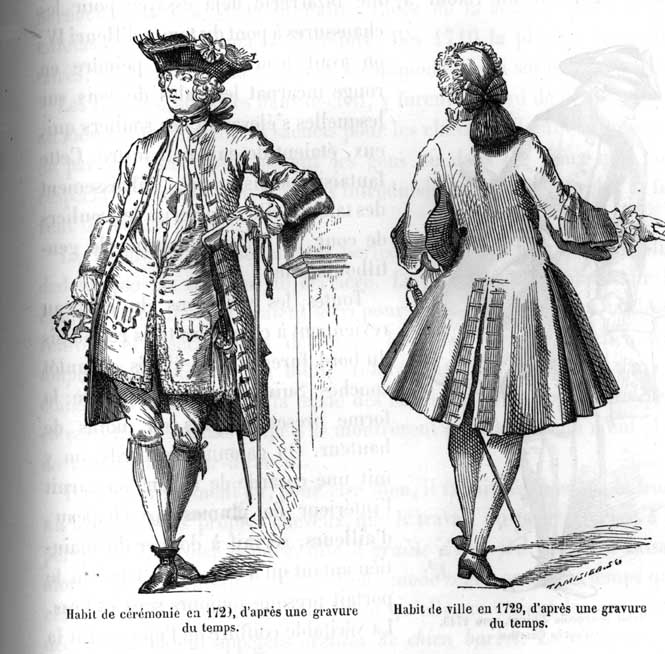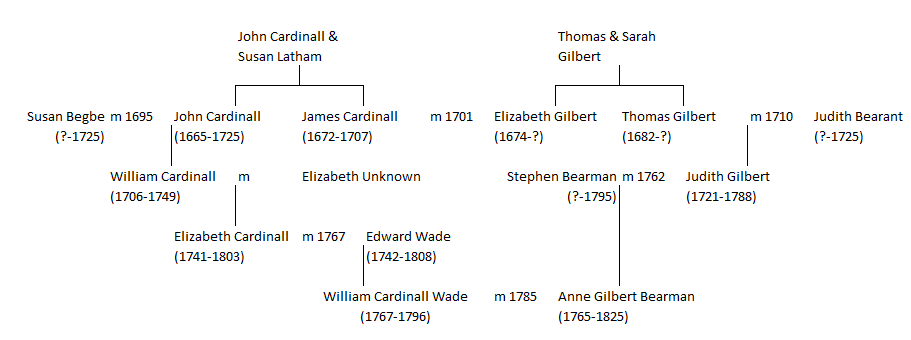Since originally writing this, I have discovered who William’s wife was. See Theobald in Great Clacton and Whittaker in St Osyth). I have also found William’s administration document, which tells us that he was a widower when he died in December 1749, and also that he had a son called William, who was previously unknown. This article has been updated to include this new information. September 2025.
We know that John Cardinall (1665-1725) had two sons called William, one of whom died before his second birthday, and another baptised in Tendring in 1706. He pops up in the James Clarkson documents at the Essex Record Office as a beneficiary of Clarkson’s will, and William Cardinall of Alresford turns up in later documents when Henry Wale, Clarkson’s grandson, accused William of stealing his wood.
On 9th July 1724, William, son of John Cardinall, was apprenticed to a Bentley (Great or Little is unclear) blacksmith called James Martin. It is entirely possible that this is our William, born in about 1706 – he would have been about 18 at the time. His father died the following year, and William came into his share of various properties which had belonged to James Clarkson. Did William throw over his apprenticeship, or carry on?
As well as evidence that William Cardinall was in Alresford through the Henry Wale’s accusation of his theft (I think the fact that this is a Cardinall involved in Wale’s woes strongly suggests that it’s William the son of John), there’s also a William Cardinall who turns up in the parish register. He married a woman called Elizabeth (who from other evidence we know to have been the daughter of Anthony Theobald and Sarah Whittaker). A daughter called Elizabeth died in Alresford in 1739[1]Recorded in the burials I found in the churchwardens’ accounts, before the earliest surviving parish register for Alresford begins in 1742. , then two further daughters were baptised there: Elizabeth in 1743 and Sarah in 1744. He was a churchwarden and he appears in the churchwardens’ accounts for several years, signing them off the accounts with his colleagues.
William was buried on 11th December 1749. His administration states that he was a widower, which means that the Elizabeth Cardinal buried in St Osyth on 8 December was his wife (her mother’s Whittaker relatives still lived in the parish).[2]It looks as if there was an unpleasant illness doing the rounds in the area in late 1749, as a similar tragedy struck the Demaid family. Peter Demaid, from a Huguenot family, lived in St Osyth. His … Continue reading The administration also says that he had a son called William – this was a new discovery, but I have no idea what happened to him.
Administration was granted to Thomas Whiting on 2 January 1749/50, as “uncle-in-law” to William’s three orphaned children. Thomas had married William’s sister, Mary, in Brightlingsea in 1740. This means, I think, that the “Sarah Carnal” who married William Smith in Brightlingsea in 1764 was William Cardinall and Elizabeth Theobald’s youngest child. She presumably lived with her aunt and uncle in the town following her parents’ death. The administration says that William was living in Thorrington at the time of his decease. No abode is given in the Alresford burial register, but the two parishes are right next to each other, so it’s not surprising he could’ve been living there.
While I can’t trace his son William (aside from a possible burial in Tendring in 1799 – which could be him, or could be a William Cardinall born in Beaumont-cum-Moze) or his sister Sarah, aside from the births of three children, it seems that his daughter Elizabeth moved at some point to Layer-de-la-Haye. Some of her relatives on her mother’s Whittaker side had moved down there.
Edward Wade married Elizabeth Cardinall in Layer-de-la-Haye in 1767, when William’s daughter would have been 26. The age at death of Edward’s wife makes her a possible daughter of William’s, and their son, William Cardinall Wade, went to live in Tendring. He married Anne Gilbert Bearman, whose great-aunt, Elizabeth Bearman, married James Cardinall (1672-1707). James, a son of John Cardinall and Susan Latham, was William Cardinall’s uncle, as this simplified family tree tries to show:
One of the witnesses of Edward and Elizabeth’s marriage was Charles Tiffin, who was a farmer and landowner in Layer, and they gave the middle name “Whittaker” to one of their daughters, Sarah – this was continued for several generations, and we now know that it was the maiden name of Elizabeth’s maternal grandmother. But there were other Whittakers about – the Wades moved to Fingringhoe where we find the marriage of Sarah Whittaker and John Tiffin in 1762 (we might suppose that John Tiffin and Charles Tiffin are close relatives). Sarah was possibly the sister of Mary Whittaker (they would be the children of John Whittaker and Mary Davall), who married Thomas Cooper in Ramsey in 1755 – this takes us to the Tendring Hundred once again. Edward and Elizabeth Wade are buried just in front of Thomas and Mary Cooper in Fingringhoe churchyard, which implies a family connection.
Interestingly, in the bundles of papers concerned with James Clarkson’s will, someone has added a note on paper, in pencil, in what could be 20th century handwriting. They’ve added it to one of Elizabeth Wale’s notebooks recording her exploits in executing her husband’s will, and the fact that it’s been written in pencil and is in an archive suggests to me that it was written by another researcher who had visited ERO to look at the papers. They wrote:
“Draft of indenture John Rayner of Wivenhoe, Surgeon and Sarah his wife, and Thomas Coop of Fingringhoe and Margaret? His wife of [an?] part Richard Freshfield of Colchester, property in Polstead, Suffolk, 1739.”
Why? What on earth has this to do with James Clarkson? The only thing I can think is that another researcher thinks there’s a link between the Cooper/Whittakers and the Cardinalls. Thomas Cooper, who married Mary Whittaker, was the son of another Thomas Cooper senior and his wife Margaret (I haven’t found their marriage yet either so I don’t know her maiden name). John Rayner’s wife, Sarah, was the daughter of Thomas Cooper senior and Margaret, and Thomas senior had lived in Polstead, Suffolk. He in turn was the son of another Thomas Cooper, and his wife Elizabeth Mash, who had married in Boxford, Suffolk, in 1681. As the name Mash crops up in the story of the Tendring Cardinalls, it’s tempting to see a connection there too. Another point to make is that whilst Thomas Cooper junior married his wife Mary in Ramsey, his sister, Judith, was living in Ramsey in the 1760s.
Cardinalls in Layer-de-la-Haye
A problem we have is that early registers for Layer-de-la-Haye haven’t survived – marriages start 1755, and baptisms and burials in 1767. Before realising that William had been a widower when he died in December 1749, I had wondered if his wife had remarried in Layer-de-la-Haye, moving there because her family lived there, and that record had vanished in a lost register. But we know that’s not the case now as Elizabeth had died before him. It seems that his daughter Elizabeth moved to Layer-de-la-Haye because it’s where her cousins had moved to.
To confuse matters, there’s evidence of an ‘early Cardinall’ in Layer – Susan Cardinall, a widow who lived there when she wrote her will in 1659. It was proved in 1666. In her will she mentions two sons, Thomas and William, and three grandchildren: Thomas, Samuel and Susan Pilgrim. I had wondered if Edward Wade’s wife was a descendant of Susan, and had nothing to do with the Tendring Cardinalls at all. But that’s not the case, as I was able to identify her as the widow of one of the East Bergholt Cardinalls, William Cardinall of Grey’s Inn. It seems to be just coincidence that she was there a century before her distant cousin Elizabeth Cardinall arrived, because it’s where relatives on her mother’s side – not the Cardinall side – had gone.
Footnotes
| ↑1 | Recorded in the burials I found in the churchwardens’ accounts, before the earliest surviving parish register for Alresford begins in 1742. |
|---|---|
| ↑2 | It looks as if there was an unpleasant illness doing the rounds in the area in late 1749, as a similar tragedy struck the Demaid family. Peter Demaid, from a Huguenot family, lived in St Osyth. His third wife, Mary, had a son called William, baptised in October 1749. Then in a matter of months, they die: Mary was buried on 30 Nov 1749, and Peter and William within six days of each other in December. Peter Demaid’s administration appears on the same page as William Cardinall’s. |


